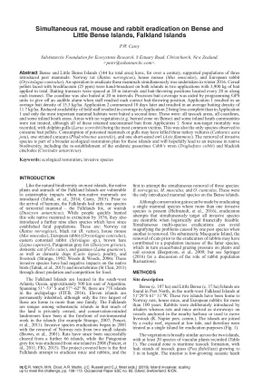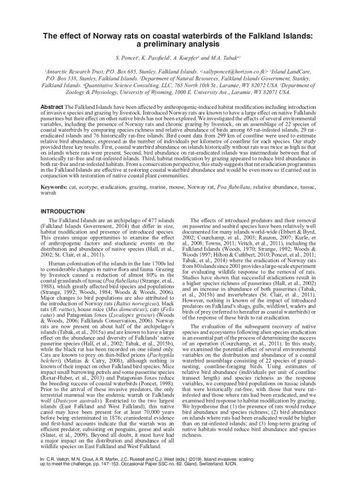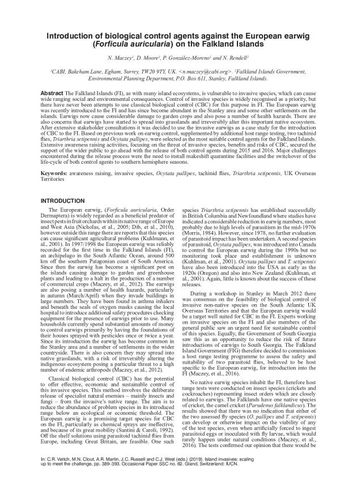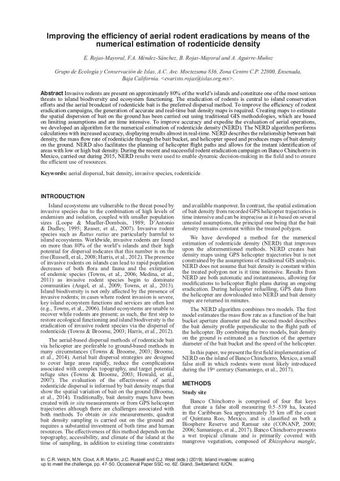Simultaneous rat, mouse and rabbit eradication on Bense and Little Bense Islands, Falkland Islands
- Description:
- Bense and Little Bense Islands (144 ha total area) have, for over a century, supported populations of three introduced pest mammals: Norway rat (Rattus norvegicus), house mouse (Mus musculus), and European rabbit (Oryctolagus cuniculus). An operation to eradicate these mammals simultaneously was undertaken in winter 2016. Cereal pellets laced with brodifacoum (25 ppm) were hand-broadcast on both islands in two applications with 3,900 kg of bait applied in total. Baiting transects were spaced at 20 m intervals and bait-throwing positions located every 20 m along each transect. The coastline was also baited at 20 m intervals. Precision bait coverage was aided by programming GPS units to give off an audible alarm when staff reached each correct bait-throwing position. Application 1 resulted in an average bait density of 15.3 kg/ha. Application 2 commenced 10 days later and resulted in an average baiting density of 11.7 kg/ha. Reduced availability of fi eld staff resulted in coverage in Application 2 being less complete than in Application 1 and only the most important mammal habitats were baited a second time. These were: all tussock areas, all coastlines, and some inland heath areas. Areas with no vegetation (e.g. burned zone on Bense) and some inland heath communities were not treated, although all of these retained unconsumed bait from Application 1. Some non-target mortality was recorded, with dolphin gulls (Larus scoresbii) being the most common victims. This was also the only species observed to consume bait pellets. Consumption of poisoned mammals or gulls may have killed three turkey vultures (Cathartes aura jota), one striated caracara (Phalcoboenus australis), and one short-eared owl (Asio flammeus). The removal of invasive species is part of a broader ecological restoration plan for these islands and will hopefully lead to an increase in native biodiversity, including the re-establishment of the endemic passerines Cobbs wren (Troglodytes cobbi) and blackish cinclodes (Cinclodes antarcticus).
- Display date:
- 2019
- Collections:
- Secretariat of the Pacific Regional Environment Programme (SPREP)
- Publisher:
- International Union for Nature Conservation (IUCN)
- Content partner:
- Secretariat of the Pacific Regional Environment Programme (SPREP)
- Availability:
- Not specified
-
Copyright status: All rights reservedFind out more about what you are able to do with this itemThis item is all rights reserved, with means you'll have to get permission from Secretariat of the Pacific Regional Environment Programme (SPREP) before using it. For more information, please see our use and reuse page.What can I do with this item?Non-infringing useNZ copyright law does not prevent every use of a copyright work, and this item may be hosted by an international institute or organisation. You should consider what you can and cannot do with a copyright work.No sharingYou may not copy and/or share this item with others without further permission. This includes posting it on your blog, using it in a presentation, or any other public use.No modifyingYou are not allowed to adapt or remix this item into any other works.No commercial useYou may not use this item commercially.
Related items
Welcome and warm Pasifik greetings
The information on this site has been gathered from our content partners.
The names, terms, and labels that we present on the site may contain images or voices of deceased persons and may also reflect the bias, norms, and perspective of the period of time in which they were created. We accept that these may not be appropriate today.
If you have any concerns or questions about an item, please contact us.



